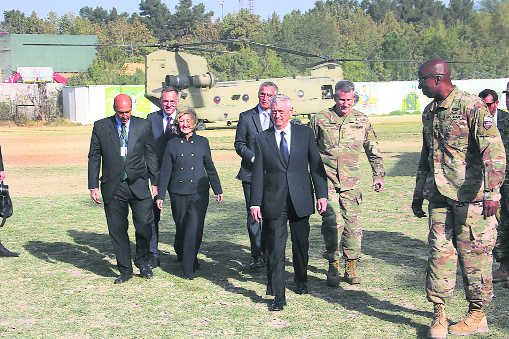
US Defence Secretary Jim Mattis is the driving force behind the new drone policy after offering ‘one last chance’ to Islamabad to rein in the Taliban and Haqqanis.
Maj Gen Ashok K Mehta (retd)
AFGHANISTAN has gone off India’s radar, a country in which it has invested an unprecedented $3 billion and has a vital strategic stake. With President Trump at the helm in the US, these are not just uncertain but unpredictable times. The case of Afghanistan is beguiling. In his first policy pronouncement on South Asia and Afghanistan on August 22, 2017, he tore into Pakistan calling it evil and deceitful while praising India for the great development work it was doing in Afghanistan. The unprecedented indictment of Pakistan was followed by his Defence Secretary Jim Mattis issuing “one last chance” to Islamabad to rein in the Taliban and Haqqani network who were killing US soldiers in Afghanistan. He added that the President had authorised the use of “all means possible” for securing Pakistan’s compliance.
The Mattis reference was to the use of drones. After his policy speech and issuance of the National Security Strategy paper in which he welcomed India’s emergence as a leading global power and stronger strategic and defence partner, Trump gave a free hand to his Generals in Afghanistan to prosecute the standoff war against terrorist hideouts in Pakistan, especially in Kurram agency, to take out Taliban and Haqqani leaders who had relocated there as it was considered a drone-free zone.
The last drone strike under the Obama regime inside Pakistan and outside the notified areas was on May 21, 2016, when Mullah Mansoor, the Taliban supreme leader was killed on the Iran-Balochistan border for reneging on the quadrilateral talks (US-Afghanistan-Pakistan-China) which were to be held under the existing constitution with the Taliban pledging to renounce violence. Since then, the Chinese and Russians who are spotlighting ISIS and not Taliban as threat have also been in the forefront of the reconciliation process but Kabul is clearly in favour of talks being held under American aegis.
Once Trump had given the go-ahead for more aggressive use of armed drones with rules of engagement substantially more liberal from those previously authorised, the Bureau of Investigative Journalism (BOIJ), an NGO which monitors air and drone strikes in areas of armed conflict, reported that Trump’s first drone strike consisting of one missile after the August 2017 warning to Pakistan was on September 15 in Kurram agency. Before this, five to six drone strikes carried out after Trump became President were inside FATA, the region free for strikes. BOIJ quoted Trump as vowing: “US will no longer be silent about Pakistan’s safe havens for terrorist organisations”. Between October 16 and 31, about 60 missiles targeted the Haqqani and Taliban leadership in Kurram agency, killing 170 to 180 terrorists. This was followed by more strikes on November 30 and December 26, 2017, in which senior Haqqani commanders were killed. The heaviest barrage of attacks was on October 31.
In 2018, four drone attacks, all in Kurram, targeted Haqqani commanders. And then, there was a blackout on information on drone strikes in Pakistan. Mattis gave orders to maintain secrecy about drone strikes. This could have been done due to protests by Pakistan by defence minister Khawaja Asif, army chief Gen Bajwa and air chief Sohail Aman who ordered the shooting down of US drones. The blackout did not mean that drone strikes had been suspended, only that the CIA was not releasing data on them. Compared to the Obama period drone strikes have been more frequent and lethal under the Trump administration, rolling back Obama constraints like civilian casualties and transparency. But there is a caveat: since May 2018, in addition to the blackout, rules of engagement are reported to have changed with less accountability and oversight of operations. Apparently, the drone strikes have weakened the Taliban/Haqqani network. Altogether nearly 200 to 230 terrorists, including four to five leaders have been taken out till May 2018.
Senior US State Department official Alice Wells travelled to Afghanistan and Pakistan last week to explore the possibility of resuming the Afghan reconciliation process. Ghani’s extended Eid ceasefire had created a favourable atmosphere for a negotiated solution. The Taliban, however, want direct talks with the US, not with Afghanistan. This is the first time both Afghanistan and the US have offered unconditional talks between Kabul and the Taliban. Wells noted that it was Taliban leaders residing in Pakistan who are an obstacle to peace talks. The Taliban last week once again rejected the offer of peace talks while foreign soldiers are still on Afghan soil. But US Secretary of State Mike Pompeo in Kabul this week spoke about “new hope” for peace talks. The pressure of drone strikes and other coercive measures are obviously working even though Pakistan and the Taliban might pretend otherwise.
Accommodating even the reconcilable Taliban in government is clearly not in India’s national interest but will work fine with Pakistan. Trump’s stance is evident: he lavished praise on India last year while condemning Pakistan for harbouring terrorists. US National Security Strategy paper also raised India’s profile as a strong global partner for the US. Further, US sanctions on Iran have put India in a spot over its commitment on Chabahar Port. Iran’s deputy ambassador in New Delhi, Masood Rahaji, on Tuesday, criticised India for not fulfilling its promises for expansion of the port and other connectivity projects including the railway line to Zahedan.
The strategic outflanking of Pakistan via Chabahar is also in jeopardy due to threatened US sanctions. External Affairs Minister Sushma Swaraj has said India will only honour UN sanctions, not those by any other country. In the rescheduled 2+2 talks with the US in September, India’s stakes in Afghanistan must be unequivocally asserted and the risks and dangers to the peace process by bending over backwards to appease the Taliban red-flagged.
India convenor of Track II regional approach to Afghanistan


























